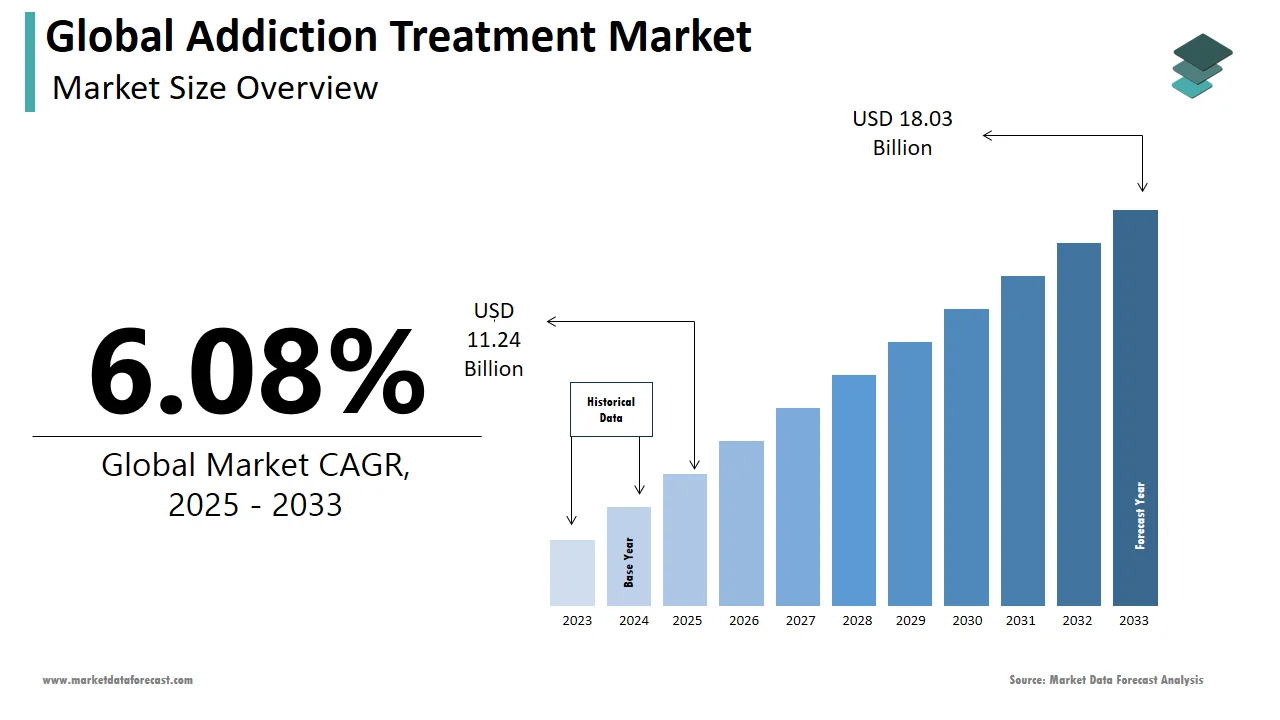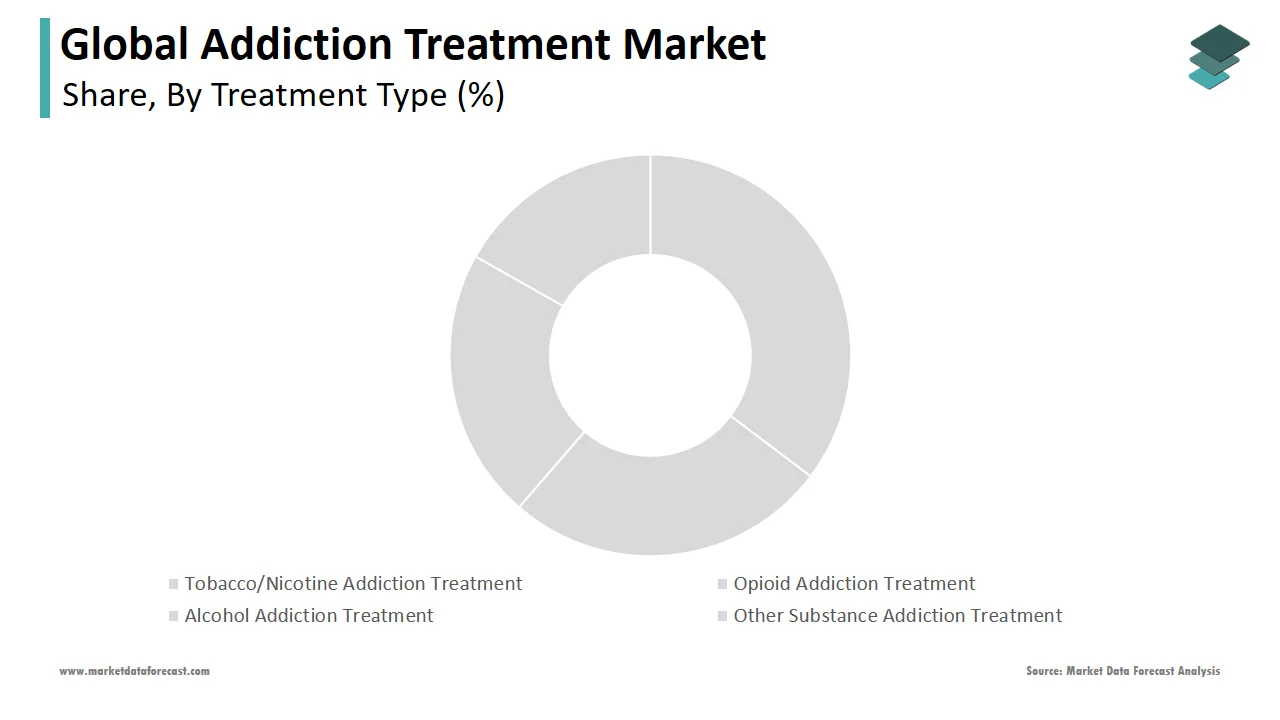Global Addiction Treatment Market Size, Share, Trends & Growth Forecast Report By Treatment Type (Tobacco/Nicotine Addiction Treatment, Opioid Addiction Treatment, Alcohol Addiction Treatment, Other Substance Addiction Treatment), Drug Type (Bupropion, Varenicline, Acamprosate, Buprenorphine, Disulfiram, Methadone, Naltrexone, Nicotine Replacement Products, Others), Treatment Centre and Region (North America, Europe, Asia-Pacific, Latin America, Middle East and Africa), Industry Analysis From 2025 To 2033.
Global Addiction Treatment Market Size
The global addiction treatment market was worth US$ 10.6 billion in 2024 and is anticipated to reach a valuation of US$ 18.03 billion by 2033 from US$ 11.24 billion in 2025, and it is predicted to register a CAGR of 6.08% during the forecast period 2025-2033.

Addiction refers to the state of being unable to refuse the consumption of a particular substance. Addiction usually occurs with prescription drugs, heroin, alcohol, cannabis, cocaine, and amphetamines. These are called psychoactive drugs, which stimulate the nervous system and give the consumer a world kind of experience and state of euphoria, which causes addiction in the consumers. Addiction provokes repeated use of substances that are derogatory to the body. It is a mental disorder; it makes people consume substances even while knowing it is harmful to their bodies. Addiction is a psychological condition that is treated in various ways. The purpose of addiction treatment is to stop patients' compulsive substance abuse habits and induce self-control. Addiction can occur for multiple reasons and can lead to chronic diseases in individuals. For example, cigarette smoking has helped increase the number of cases of lung cancer, and tobacco consumption kills around 8 million people annually. Therefore, as the situation becomes adverse, there is a rising need for addiction treatment. The addiction treatment market works around the various substances and institutions and ways addiction is cured.
MARKET DRIVERS
Rising product approvals and launches, de-addiction programs from numerous organizations, and the increasing prevalence of dependency on psychoactive drugs such as alcohol, opioid, tobacco, cocaine, heroin, marijuana, and others are majorly propelling the global addiction treatment market.
Additionally, following the increasing number of nicotine addiction cases, public and private groups are working to raise knowledge about nicotine de-addiction, which helps smokers who are addicted to stop smoking and aids cessation. For instance, to raise awareness about quitting smoking, Public Health England conducted a US$ 1.3 million smoking cessation campaign in 2017.
Acquisitions and mergers to promote the addiction treatment market growth.
To enhance their market presence, leading players active in the market for addiction treatment are concentrating on adopting inorganic development tactics, including acquisitions, mergers, partnerships, and collaborations. For instance, the recently approved methadone hydrochloride 5 mg and 10 mg tablets from Elite Laboratories Inc., a specialty pharmaceutical business, were distributed by Glenmark Pharmaceuticals Ltd., a major integrated research-based, worldwide pharmaceutical corporation. According to the agreement, Elite will get a manufacturing license for methadone, and Glenmark Pharmaceuticals, Inc. will sell and distribute methadone for Elite in the United States.
MARKET RESTRAINTS
However, factors such as hesitance and noncompliance of addicted patients to join the treatment facility, along with withdrawal and relapse of patients during treatment, can prove to be a drawback to the growth of the global addiction treatment market.
Impact of covid-19 on the global addiction treatment market
According to preliminary data, the COVID-19 epidemic has caused an increase in drug overdoses. According to current provisional data from the Centers for Disease Control and Prevention, it is expected that more than 93,000 drug overdose deaths will occur in the United States in 2020, the most overdose deaths ever recorded in a calendar year and an almost 30% rise from 2019. Data showed that after the national emergency was declared in March 2020, there has been a significant rise in the use of many different types of drugs in the United States. According to researchers, the number of positive urine drug tests requested by medical professionals and judicial institutions has increased. These statistics show an increase from previous years in the number of fentanyl, cocaine, heroin, and methamphetamine-positive screens. Studies from the U.S. and other nations also indicate that many persons increased their alcohol and cannabis (marijuana) consumption, particularly those depressed or anxious clinically and those under stress because of COVID-19. Although further research is required to fully understand how social isolation and pandemic-related stress connect to increases in drug use and poor substance use outcomes, NIDA continues to fund and carry out research to understand better and address pandemic-related risk factors for substance use and substance use disorders. Thus, COVID-19 has further heightened the need for the addiction treatment market.
REPORT COVERAGE
|
REPORT METRIC |
DETAILS |
|
Market Size Available |
2024 to 2033 |
|
Base Year |
2024 |
|
Forecast Period |
2025 to 2033 |
|
CAGR |
6.08% |
|
Segments Covered |
By Treatment Type, Drug Type, Treatment Centre, Distribution channel, and Region. |
|
Various Analyses Covered |
Global, Regional, and country-level analysis; Segment-Level Analysis, DROC; PESTLE Analysis; Porter’s Five Forces Analysis, Competitive Landscape; Analyst Overview of Investment Opportunities |
|
Regions Covered |
North America, Europe, APAC, Latin America, Middle East & Africa |
|
Market Leaders Profiled |
Pfizer Inc., Mallinckrodt, Orexo AB, Indivor Plc, Teva Pharmaceutical Industries Ltd, GlaxoSmithKline Plc, Cipla Ltd., Alkermes Plc, Hikma Pharmaceuticals PLC, Titan Pharmaceuticals, Inc., Indivor Plc, Dr. Reddy's Labarotories Limited, Perrigo Company Plc, and Mylan N.V. , and Others. |
SEGMENTAL ANALYSIS
By Treatment Type Insights

Based on treatment type, the nicotine addiction segment is expected to show rapid growth during the forecast period due to the rise in tobacco consumption as cigarettes around the world. In addition, the accessibility and availability of nicotine replacement drugs like transdermal patches, oral sprays, nicotine gum, etc., help the market grow.
By Drug Type Insights
Due to an increase in product introductions, the sector for nicotine replacement therapies is estimated to hold the most significant share of the global addiction treatment market during the forecast period. The methadone segment is also estimated to contribute to the growth as a generic version of Dolophine, methadone hydrochloride tablets, USP in strengths of 5 mg and 10 mg, was introduced by the generic pharmaceutical company Epic Pharma, LLC in the recent period. The management of pain indication and the treatment of opioid addiction is indicated for methadone hydrochloride tablets, thus increasing the demand for the tablets.
By Treatment Centre Insights
The inpatient category is the most common type of rehab for drug addicts and is expected to continue growing during the forecast period. Inpatient refers to the patients who stay in centers and are continuously monitored and treated.
By Distribution Channel Insights
Based on the distribution channel, the hospital pharmacies segment is the most common distribution channel in the addiction treatment market. Factors such as increased awareness of drug side effects and faster detection and treatment of individuals in hospitals with the option of admitting patients in critical conditions contribute to the segment's growth.
REGIONAL ANALYSIS

Geographically, North America is projected to hold the largest share of the global addiction treatment market during the forecast period due to rising illicit drug use, an increase in the number of smokers, and growing concerns about health problems for both active and passive smokers. Furthermore, with the developments of addiction treatment in countries like the U.S. and Canada, with high addiction rates, the region is anticipated to record a significant share in the market. In addition, the development of the healthcare sector and the legalization of marijuana are expected to spur market expansion.
Europe is anticipated to witness a prominent share in the global addiction treatment market during the forecast period. However, due to a rise in the consumption of tobacco products and alcohol addiction in this region. In countries like the U.K., which have approximately 3.2 million people who have taken a drug according to 2018-19 stats, and other countries like Germany, Italy, France, etc., the market in the region is progressing.
Due to rising medical tourism, declining therapy costs, and an increase in tobacco users and smokers, Asia-Pacific will experience a very high growth rate. This growth is also due to a significant increase in therapeutic facilities and ongoing government initiatives to raise public awareness of addiction in countries like India, China, Japan, South Korea, etc.
KEY MARKET PLAYERS
The global addiction treatment market has several international as well as regional players. However, a few of the notable players in the market are Pfizer Inc., Mallinckrodt, Orexo AB, Indivor Plc, Teva Pharmaceutical Industries Ltd, GlaxoSmithKline Plc, Cipla Ltd., Alkermes Plc, Hikma Pharmaceuticals PLC, Titan Pharmaceuticals, Inc., Indivor Plc, Dr. Reddy's Labarotories Limited, Perrigo Company Plc, and Mylan N.V.
RECENT MARKET DEVELOPMENTS
- On June 13th, 2022, the Bringham and Women's hospital researchers identified a brain circuit that can be targeted to treat addiction. The researchers use brain lesion mapping to map out the brain circuits and imply addiction remission to them.
- On June 10th, 2022, it was announced that boulder care, a startup company from Portland that uses telehealth to treat people with addiction, raised $36 million to develop better telehealth care.
MARKET SEGMENTATION
This research report on the global addiction treatment market has been segmented and sub-segmented based on the treatment type, drug type, treatment center, distribution channel, and region.
By Treatment Type
- Tobacco/Nicotine Addiction Treatment
- Opioid Addiction Treatment
- Alcohol Addiction Treatment
- Other Substance Addiction Treatment
By Drug Type
- Bupropion
- Varenicline
- Acamprosate
- Buprenorphine
- Disulfiram
- Methadone
- Naltrexone
- Nicotine Replacement Products
- Others
By Treatment Centre
- Outpatient Treatment Centers
- Inpatient Treatment Centers
- Residential Treatment Centers
By Distribution Channel
- Hospital Pharmacies
- Medical Stores
- Others
By Region
- North America
- Europe
- Asia Pacific
- Latin America
- Middle East and Africa
Frequently Asked Questions
How big is the addiction treatment market?
In the recent past, the recent COVID-19 pandemic favored the growth rate of the global addiction treatment market.
Which region is growing the fastest in the global addiction treatment market?
The global addiction treatment market size is grow USD 18.03 billion by 2033.
Who are the key players in the addiction treatment market?
Pfizer Inc., Mallinckrodt, Orexo AB, Indivor Plc, Teva Pharmaceutical Industries Ltd, GlaxoSmithKline Plc, Cipla Ltd., Alkermes Plc, Hikma Pharmaceuticals PLC, Titan Pharmaceuticals, Inc., Indivor Plc, Dr. Reddy's Labarotories Limited, Perrigo Company Plc, and Mylan N.V. are some of the notable players in the global addiction treatment market.
Related Reports
Access the study in MULTIPLE FORMATS
Purchase options starting from $ 2500
Didn’t find what you’re looking for?
TALK TO OUR ANALYST TEAM
Need something within your budget?
NO WORRIES! WE GOT YOU COVERED!
Call us on: +1 888 702 9696 (U.S Toll Free)
Write to us: sales@marketdataforecast.com
